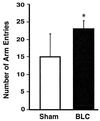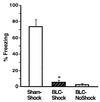Basolateral amygdala is not critical for cognitive memory of contextual fear conditioning
- PMID: 9844005
- PMCID: PMC24565
- DOI: 10.1073/pnas.95.25.15003
Basolateral amygdala is not critical for cognitive memory of contextual fear conditioning
Abstract
Evidence that lesions of the basolateral amygdala complex (BLC) impair memory for fear conditioning in rats, measured by lack of "freezing" behavior in the presence of cues previously paired with footshocks, has suggested that the BLC may be a critical locus for the memory of fear conditioning. However, evidence that BLC lesions may impair unlearned as well as conditioned freezing makes it difficult to interpret the findings of studies assessing conditioned fear with freezing. The present study investigated whether such lesions prevent the expression of several measures of memory for contextual fear conditioning in addition to freezing. On day 1, rats with sham lesions or BLC lesions explored a Y maze. The BLC-lesioned rats (BLC rats) displayed a greater exploratory activity. On day 2, each of the rats was placed in the "shock" arm of the maze, and all of the sham and half of the BLC rats received footshocks. A 24-hr retention test assessed the freezing, time spent per arm, entries per arm, and initial entry into the shock arm. As previously reported, shocked BLC rats displayed little freezing. However, the other measures indicated that the shocked BLC rats remembered the fear conditioning. They entered less readily and less often and spent less time in the shock arm than did the control nonshocked BLC rats. Compared with the sham rats, the shocked BLC rats entered more quickly and more often and spent more time in the shock arm. These findings indicate that an intact BLC is not essential for the formation and expression of long-term cognitive/explicit memory of contextual fear conditioning.
Figures







References
Publication types
MeSH terms
Grants and funding
LinkOut - more resources
Full Text Sources
Medical
Research Materials

